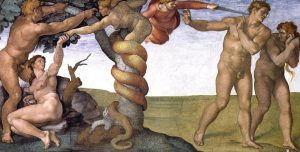The story of the Abramelin-book involves Abraham of Worms passing his magical and Kabbalistic secrets on to his son and tells how he acquired his knowledge.
The book has the form of an epistolary novel, styled as an autobiography. The character of Abraham of Worms narrates his travel to the Egyptian desert and to a town bordering the Nile. An elderly Egyptian mage offers him two manuscripts containing knowledge of Kabbalistic magic, but extracts an oath that bounds Abraham in the service of God and the Divine Law.
Versions of the Abramelin book
The Book of the Sacred Magic of Abramelin the Mage exists in the form of twelve manuscripts and an early printed edition. The provenance of the text has not been definitively identified. The earliest manuscripts are two versions that date from about 1608, are written in German and are now found in Wolfenbüttel. Another two manuscripts are in Dresden, and date from about 1700 and 1750 respectively.
The first printed version dates to 1725. It was printed in Cologne by Peter Hammer. A partial copy in Hebrew is found in the Bodleian Library in Oxford (around 1740). An 18th century manuscript copy exists in French in the Bibliothèque de l’Arsenal in Paris. Another 17th-century manuscript in Italian exists in the ‘Legato Martinengo’ of the Queriniana Library in Brescia, Italy.
Demons of the Abramelin book

The listed hierarchies of spirits in The Book of the Sacred Magic of Abramelin the Mage represent the various energies that can be used by the magician. The spirits are divided into four groups. Each group corresponds to one of the four cardinal directions and one of the four elements (fire, water, air, and earth). Each group is ruled by a higher spirit and a sub-prince. These have many familiars under their power. The book describes how to summon the spirits, their appearance, abilities and the office of each spirit.
The Chief Spirits
- Lucifer
- Leviatan
- Satan
- Belial
The Eight Sub-Princes
- Astarot
- Magot
- Asmodee
- Belzebud
- Oriens
- Paimon
- Ariton
- Amaimon




